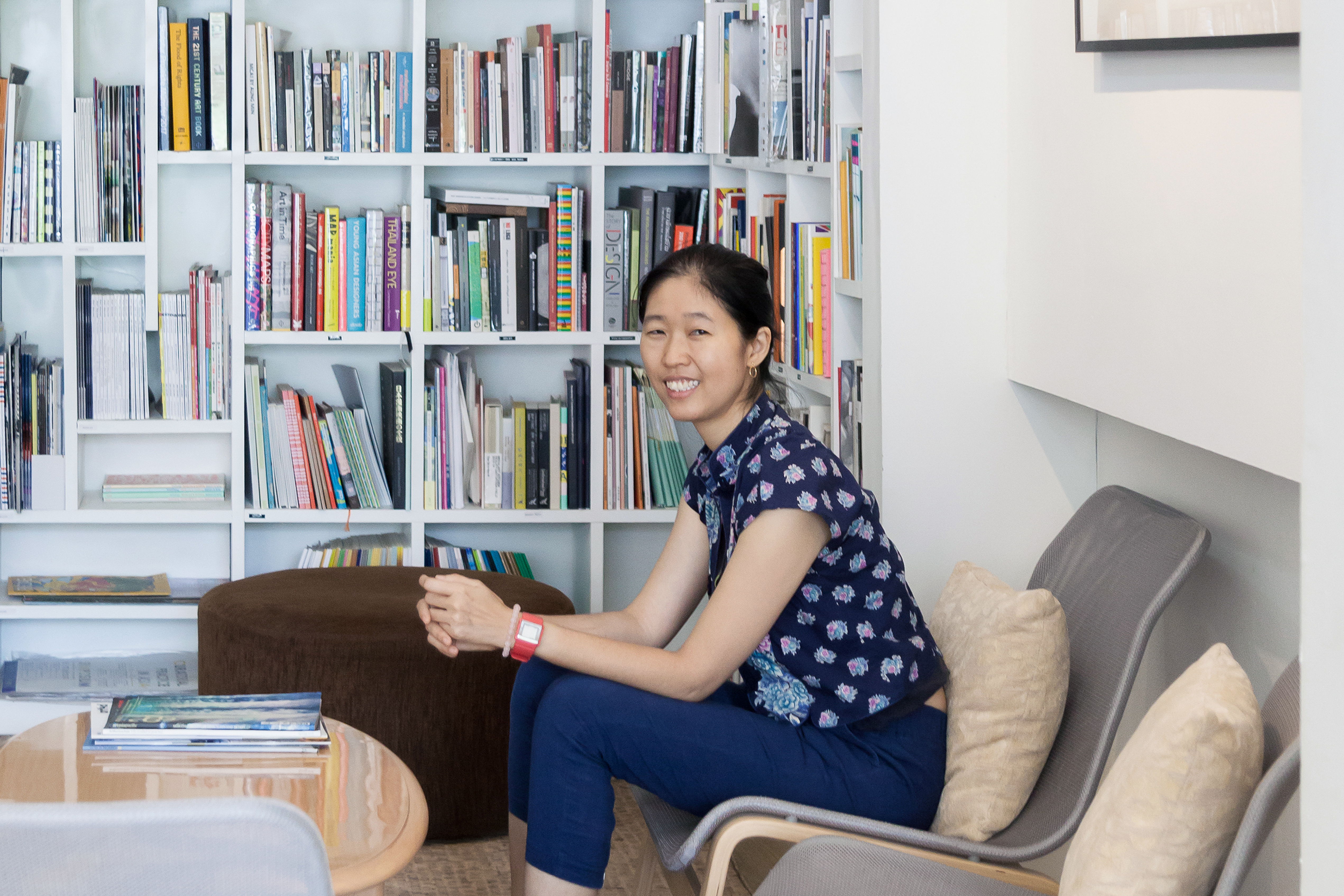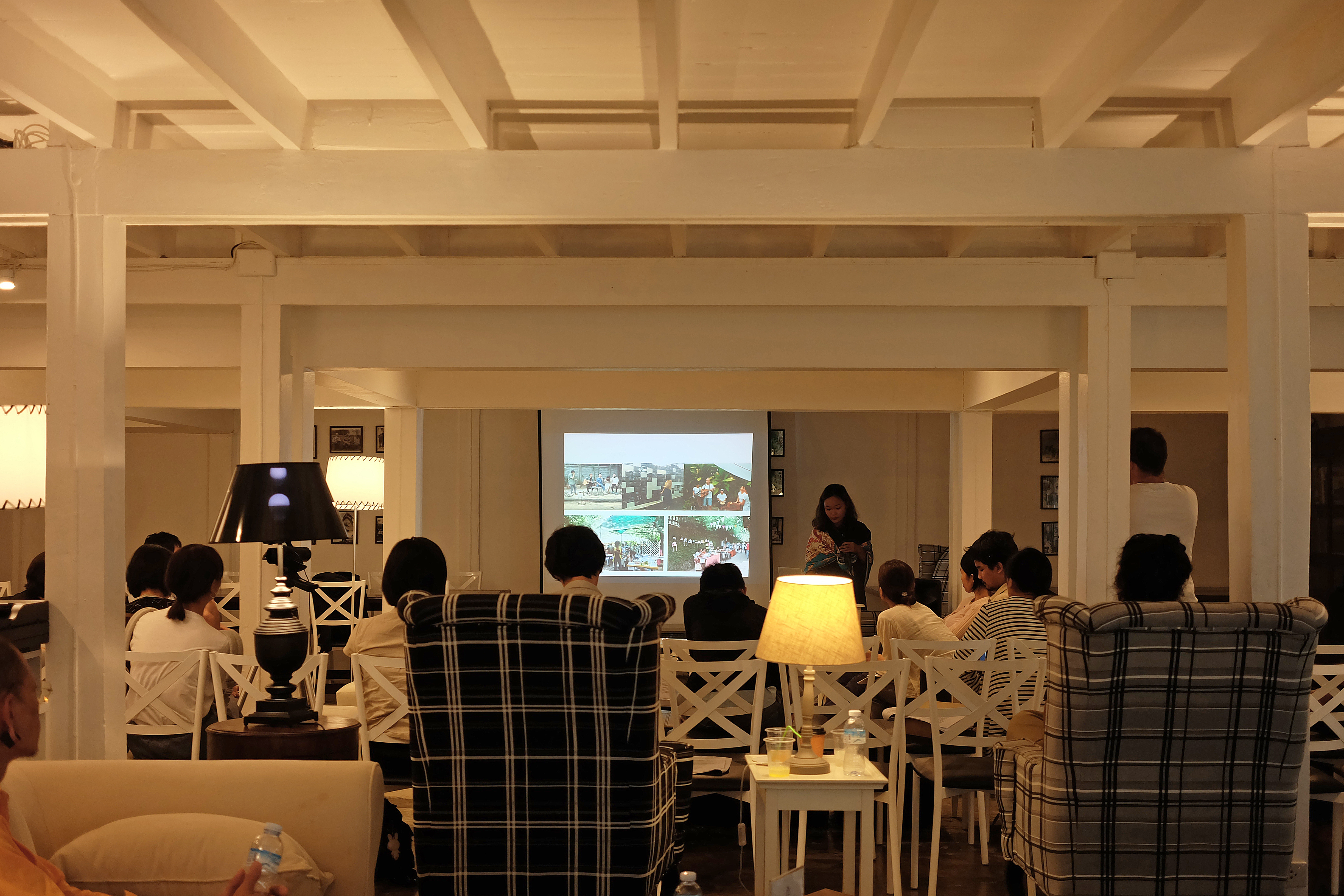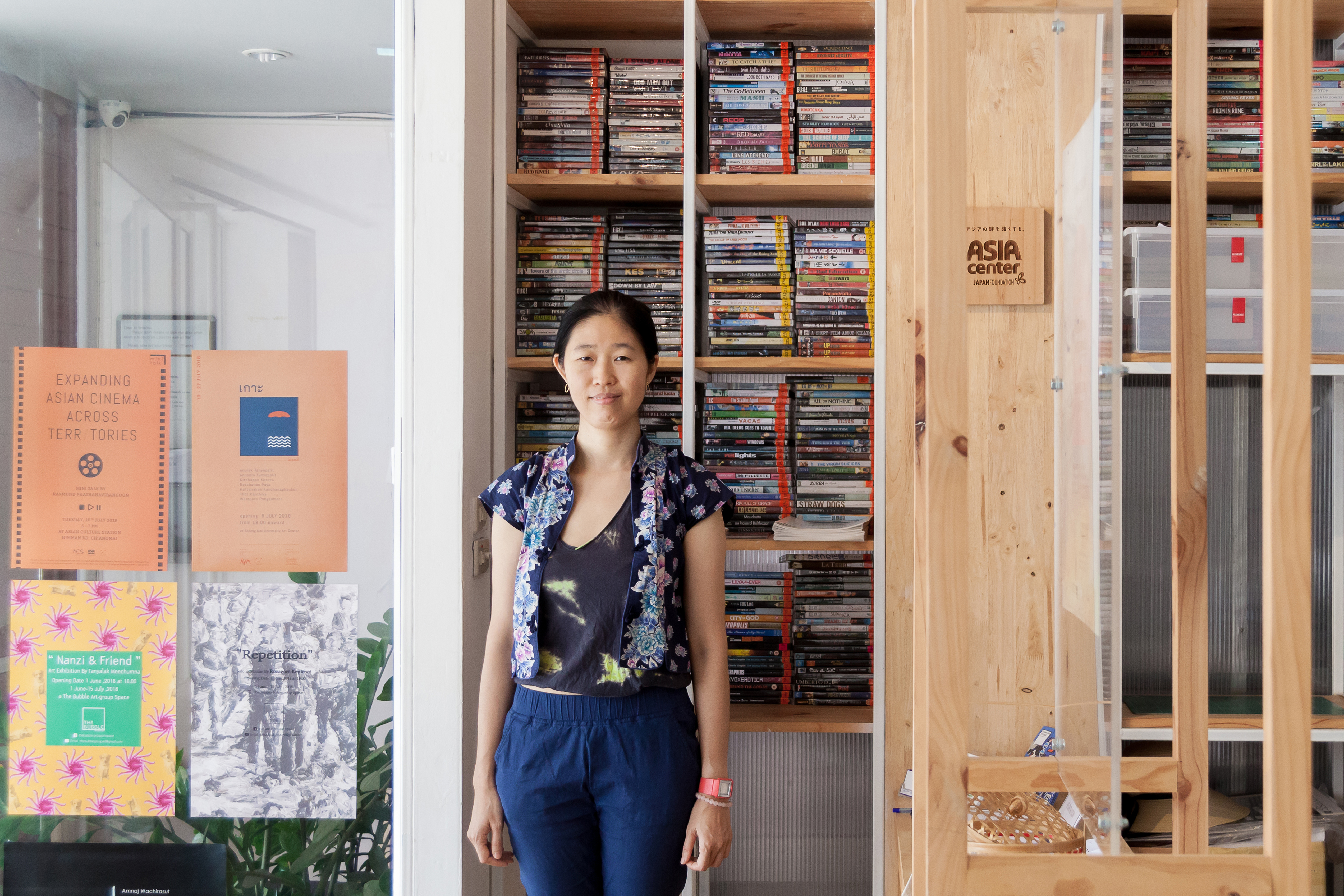ART4D TALKED WITH THE PEOPLE BEHIND THE REGIONAL ART ACTIVITIES HELD IN CHIANG MAI OVER THE PAST FEW YEARS
TEXT: NAPAT CHARITBUTRA
PORTRAIT: KETSIREE WONGWAN
PHOTO COURTESY OF CHIANG MAI ART CONVERSATION
“ตอนแรกมันเริ่มมาจากการรวมตัวกันหลวมๆ ของศิลปินที่อาศัยอยู่แถวถนนนิมมานเหมินท์ พวกเรานัดเจอกันบ่อยๆ ตามร้านกาแฟเพื่อคุยกันว่าจะทำยังไงให้บรรยากาศศิลปะในเชียงใหม่มันดีขึ้น คือเมืองมันได้ชื่อว่าเป็นเมืองศิลปะนะ แต่กลับไม่มีอะไรให้ดูมากนัก” สุทธิรัตน์ ศุภปริญญา หนึ่งในผู้ก่อตั้ง Chiang Mai Art Conversation (CAC) พูดถึงที่มาขององค์กรศิลปะไม่แสวงหาผลกำไรแห่งนี้ว่า ไอเดียเริ่มแรกคือการทำงานสเกลใหญ่ๆ อย่างเทศกาลศิลปะ ก่อนจะค่อยๆ ลดสเกลลงมาทำสิ่งที่สำคัญและเป็นรากฐานก่อนนั่นคือการทำงาน archive

“เราเริ่มจากการเปิดเพจเฟซบุ๊กเพราะมันไม่มีค่าใช้จ่าย ซึ่งพอทำขึ้นมาก็มีกลุ่มคนมาติดตามเราเลย คงเพราะเชียงใหม่ไม่เคยมีใครทำสิ่งนี้มาก่อนด้วย” บทบาทการเป็นตัวกลางระหว่างศิลปินด้วยกันและผู้สนใจทั่วไป ทำให้ CAC เติบโตได้อย่างรวดเร็ว เงินก้อนแรกที่ CAC ได้รับการสนับสนุนให้ทำกิจกรรมมาจากสถานทูตสหรัฐอเมริกาที่ต้องการจัดให้ทูตวัฒนธรรมของตนมารู้จักกับ community ต่างๆ ในเชียงใหม่ สุทธิรัตน์เล่าว่า ครั้งนั้น (ในปี 2014) เธอผลักดันโปรเจ็คต์ให้มีขนาดใหญ่มากขึ้นกว่าโจทย์ที่ได้รับมา จากโปรเจ็คต์เล็กๆ งบประมาณจัดงานแค่ 10,000 บาท มาเป็นการเชิญโครงข่ายแกลเลอรี่ในเชียงใหม่ทั้งหมดมาร่วมวงเสวนา เพื่อต่อยอดให้เกิดเป็นการทำแผนที่ศิลปะในเชียงใหม่
เรื่องของงบประมาณดูจะเป็นปัญหาหลักที่มักเกิดขึ้นกับคนทำงานศิลปะโดยเฉพาะในด้านการศึกษา “สิ่งที่เราทำเพื่อระดมทุนมาทำเว็บไซต์แผนที่คือการขอบริจาคผลงานจากศิลปินที่มีชื่อเสียง 6 คน (อารยา ราษฎร์จำเริญสุข, โฆษิต จันทรทิพย์, อภิชาติพงศ์ วีระเศรษฐกุล, ฤกษ์ฤทธิ์ ตีระวนิช, คามิน เลิศชัยประเสริฐ และ มิตร ใจอินทร์) แล้วก็ติดต่อบรรดาคอลเล็คเตอร์ไปว่าสนใจงานเหล่านี้ไหม จนกระทั่งเราได้เงินมาก้อนหนึ่งสำหรับทำเว็บไซต์” เว็บไซต์ที่ CAC คิดไว้ค่อนข้าง multifunction ทีเดียว โดยนอกจากจะบรรจุแผนที่ที่สามารถอัพเดทข้อมูลพื้นที่ใหม่ๆ และอีเวนต์ต่างๆ ได้ตลอดเวลาแล้ว ยังมีแพลตฟอร์มเตรียมไว้ให้ศิลปินและนักเขียนได้มาพูดคุยแลกเปลี่ยนกันด้วย ซึ่งหลังจากใช้เวลาพัฒนาเว็บไซต์อยู่เป็นเวลานาน แผนที่ก็เสร็จในช่วงปี 2015 และมีโอกาสได้ใช้งานจริงทันทีในงาน Galleries’ Night ที่สถานทูตฝรั่งเศสขึ้นมาจัดที่เชียงใหม่ในปี 2016

Asian Culture Station บนถนนนิมมานเหมินท์ | ASIAN CULTURE STATION ON NIMMANHAEMIN ROAD
CAC มีสถานที่ทำการเป็นเรื่องเป็นราวครั้งแรกในปี 2016 เมื่อได้รับเลือกให้เป็นพาร์ทเนอร์กับ Japan Foundation ในโปรเจ็คต์ Asian Culture Station (ACS) หลังจากต้องนัดพบกันตามร้านกาแฟมานาน ACS ตั้งอยู่ที่นิมมานเหมินท์ ซอย 4 ในพื้นที่ขนาดไม่กว้างนักของศูนย์ถูกจัดมุมให้เป็นห้องสมุด ACS Library และใช้เป็นพื้นที่จัดกิจกรรมเสวนาเล็กๆ หรือนิทรรศการศิลปะที่ปีก่อนพวกเขา เปิด open call ให้นักศึกษาศิลปะส่ง proposal เข้ามา คนที่ได้รับเลือกจะได้ร่วมงานกับคิวเรเตอร์และทดลองทำงานกับสเปซแบบอื่นที่ไม่ใช่พื้นที่กล่องสีขาวแบบห้องนิทรรศการ “มันเป็นการฝึกให้ศิลปินรุ่นใหม่ได้ทำงานจริงเขาจะได้รู้ว่าในฐานะศิลปินเขาควรโฟกัสตรงไหน ต้องมีค่าใช้จ่ายอะไรบ้าง” นอกเหนือจากการจัดนิทรรศการกับนักศึกษาสุทธิรัตน์ยังเล่าต่อไปว่าการได้รับทุนสนับสนุนจาก Japan Foundation ทำให้เธอจัดกิจกรรมได้ต่อเนื่องขึ้น จนปัจจุบันมีกิจกรรมถึง 3 ประเภทที่ถูกจัดขึ้นเป็นประจำนั่นคือ mini talk, exhibition, symposium หรือเทศกาลฉายหนัง
“เราเห็นคนที่เป็น professional ด้านต่างๆ ทยอยมาเที่ยวเชียงใหม่กันทั้งปี แล้วด้วยเราค่อนข้างรู้จักคนเยอะ พอรู้ข่าวว่าใครจะมาเชียงใหม่เราก็ติดต่อไปเลย ถ้าเขาตกลงเราก็คิดหัวข้อให้เขาแล้วก็ทำแผนประชาสัมพันธ์โครงการ” สุทธิรัตน์บอกกับ art4d ว่าคนทำงานสาย creative มักจะเชื่อมต่อกันหมดและเธอก็ใช้ความเป็นเมืองท่องเที่ยวของเชียงใหม่ให้เป็นประโยชน์กับการจัดกิจกรรมเหล่านั้น ซึ่งผลลัพธ์ที่ได้ก็คือความหลากหลายของเนื้อหากิจกรรมที่นอกเหนือไปจากศิลปะ มีอยู่ครั้งหนึ่ง ACS เคยเชิญสว่างวงศ์ ยองห้วย ศิลปินเชื้อพระวงศ์รัฐฉานผู้เป็นหลานแท้ๆ ของเจ้าส่วยแต้ก ประธานาธิบดีแห่งสหภาพพม่าคนแรกมาเสวนาเรื่องศิลปะ ซึ่งแน่นอนว่ามีผู้เข้าร่วมจากฝั่งของสาขาสังคมศาสตร์และรัฐศาสตร์หลายๆ คนทีเดียวที่เข้ามาฟังเสวนาครั้งนั้นด้วย ACS จึงไม่เชิงว่าเป็นพื้นที่ศิลปะเสียทีเดียว เพราะผู้เข้าร่วมกิจกรรมนั้นขึ้นอยู่กับเนื้อหาของกิจกรรมแต่ละครั้ง

พื้นที่ที่ไม่กว้างนักของ ACS ถูกใช้เป็นทั้งสถานที่จัดกิจกรรมเสวนา และพื้นที่จัดนิทรรศการศิลปะ | THE LIMITED SPACE INSIDE ACS IS UTILIZED AS AN EXHIBITION SPACE AND A COMMON SPACE FOR SEMINAR EVENTS
“งานที่มีกลุ่มผู้เข้าร่วมกิจกรรมหลากหลายที่สุดคงจะเป็น Nimman Film Festival ปี 2017 ที่เราใช้หอศิลป์ มช. เป็นที่จัด หนังที่เอามาฉายมีตั้งแต่ documentary, feature film, short film และภาพยนตร์เชิงทดลองหลากหลายสัญชาติในเอเชียตะวันออกเฉียงใต้กับประเทศญี่ปุ่น” เทศกาลภาพยนตร์เป็นกิจกรรมเดียวที่เก็บค่าใช้จ่ายกับผู้เข้าร่วม นอกจากกิจกรรมที่กล่าวถึงข้างต้น ในทุกๆ ปี ACS จะจัดงาน symposium โดยในแต่ละปีก็จะมีหัวข้อที่แตกต่างกัน สำหรับคนที่ติดตามข่าวสารในวงการศิลปะคงจะรู้ว่า ACS เคยจัด symposium ในหัวข้อ International Art Biennales/Triennales in Southeast Asia Context โดยเชิญคิวเรเตอร์จากเทศกาลศิลปะอื่นๆ เช่น Fram Kitagawa ผู้อำนวยการใหญ่ของ Echigo-Tsumari Art Triennale, Zoe Butt ภัณฑารักษ์ของ Sharjah Biennial 14, Alia Swastika ภัณฑารักษ์ของ 2011 Biennale Jogja XI /Equator #1 และ ดร. กฤติยา กาวีวงศ์ หนึ่งในภัณฑารักษ์ของรายการ Gwangju Biennale 2018 มาพูดคุยกันถึง biennale และ triennale อื่นๆ ที่ถูกจัดขึ้นในภูมิภาค ในโอกาสที่ประเทศไทยของเรากำลังจะมีเทศกาลศิลปะประเภทที่ว่านี้จัดขึ้นพร้อมกันถึง 3-4 รายการในช่วงปลายปีที่ผ่านมา (ในเชียงใหม่เองก็จัด Painnale ช่วงเดือนตุลาคมถึงพฤศจิกายนด้วย)
“สิ่งที่เรากำลังพยายามทำคือการสร้างเครือข่ายระหว่างองค์กรให้เกิดการแชร์ความรู้ระหว่างกัน” สุทธิรัตน์กล่าวว่าเป้าหมายสำคัญของพวกเขาคือ การเป็นสะพานเชื่อมระหว่างศิลปินไทยและวงการศิลปะนานาชาติ เพื่อให้นานาชาติได้เห็นการเคลื่อนไหวของศิลปินไทย และให้ศิลปินไทยตามการเคลื่อนไหวของสากลได้ทัน นอกจากการจัดกิจกรรมอย่างต่อเนื่อง อีกสิ่งหนึ่งที่สุทธิรัตน์มองว่าเป็นฐานสำคัญของการทำงานคือเว็บไซต์ของ CAC ที่มีทั้งภาษาไทยและภาษาอังกฤษ “มันเป็นเครื่องมือที่ทำให้คนจากโลกภายนอกหาเราเจอ โดยเฉพาะเมื่อเราอยู่เชียงใหม่ที่ไม่ได้เป็นจุดหมายหลักที่ใครๆ ก็ต้องไปอย่างกรุงเทพฯ” เราคิดว่านี่เป็นโอกาสดีทีเดียวสำหรับศิลปินในเชียงใหม่ที่สามารถเดินทางไปร่วมกิจกรรมเหล่านี้ได้อย่างง่ายดาย (ถ้าเป็นกรุงเทพฯ คงใช้คำว่า “ง่ายดาย” ไม่ได้แน่ๆ) ตอนนี้ CAC เปิดทำการมาได้ 6 ปีแล้ว ต้องรอดูกันต่อว่ากิจกรรมต่อๆ ไปของพวกเขาจะเป็นอย่างไร เพราะล่าสุด กิจกรรมสุดท้ายของโครงการ ACS จะมีขึ้นในวันที่ 31 มีนาคมที่จะถึงนี้แล้ว

“It first began with a casual collaboration between artists living in the Nimmanhaemin neighborhood. We got together on a regular basis at a café here and there to talk about how we could make Chiang Mai’s art scene better than it was. This city is known as an arts city but there isn’t really that much to see,” Sutthirat Supaparinya, one of the founders of Chiang Mai Art Conversation (CAC) discussed the origin of this non-profit art organization of which the initial idea was to develop a large-scale event such as an arts festival before reducing the scale down to the essence and foundation of it all—archiving.
“We began by opening a Facebook page simply because it didn’t cost anything. Once the page was launched, we had a group of followers almost right away and the number has continued to grow. I think because no one has done anything like this in Chiang Mai before.” The role of acting as a mediator between both artists and artists, and artists and potential audiences has caused CAC to grow fast. The first financial support granted to CAC came from the Embassy of the United States who wanted to introduce the country’s cultural attachés to local communities in Chiang Mai. Supaparinya recalled the experience when she was pushing for the project to grow into something that was much larger than it was expected to be. From a small project with only a 10,000 THB budget, the event reached another level with the operators of the network of galleries in Chiang Mai being invited to take part in the discussion, which eventually led to the creation of the city’s art map.

พื้นที่ที่ไม่กว้างนักของ ACS ถูกใช้เป็นทั้งสถานที่จัดกิจกรรมเสวนา และพื้นที่จัดนิทรรศการศิลปะ | THE LIMITED SPACE INSIDE ACS IS UTILIZED AS AN EXHIBITION SPACE AND A COMMON SPACE FOR SEMINAR EVENTS
Securing a budget seems to be a big issue that every artist has to face, particularly when it comes to the aspect of an arts education. “What we did was to raise funds to create an art map website. The donations came in the form of artworks from six reputable artists, namely Araya Rasdjarmrearnsook, Kosit Juntaratip, Apichatpong Weerasethakul, Rirkrit Tiravanija, Kamin Lertchaiprasert and Mit Jai Inn. CAC then contacted collectors who might be potentially interested in the works until we were able to put together enough money for the website.” The website they have in mind is quite multifunctional. Not only will it be able to feature the art map with constant updates of new spaces and events, but also provided is a platform for artists and writers to take part in the discussion. After a considerable period of development, the map was completed in 2015 and put into use almost immediately with the Galleries’ Night event hosted by the Embassy of France in Chiang Mai in 2016.
CAC’s official office was established in 2016 when it was chosen to partner with the Japan Foundation for the Asian Culture Station (ACS) project. After countless meetings in local cafés, ACS finally found its space on Nimmanhaemin Soi 4, located on a not-so- large plot of land with a corner being designed into an ACS Library that is also used to host small talk sessions and art exhibitions. Last year, they set up an open call for art students to submit their proposals and the selected artists will be working with curators including experimenting with unorthodox types of spaces that are not the conventional white spaces of galleries. “It is a training that allows for young artists to actually work and learn by themselves about their focus as an artist, and what are the costs that they are going to have to deal with.” In addition to organizing exhibitions with students, Supaparinya also talked about how the funds given by the Japan Foundation have allowed them to maintain the consistency of the activities. The three activities that they are able to organize on a daily basis are mini-talks, exhibitions, and symposiums or film screenings.
“We see people who are professionals from so many different disciplines and they visit Chiang Mai throughout the year. Luckily, with the connections that we have, when we hear about who is coming to Chiang Mai, we can contact them right away and if they agree, we give them a topic to work with and then we start working on the PR of the project.” Supaparinya further commented to art4d that people who work in the creative community are usually connected. Chiang Mai’s reputation as a famous tourism town is used to benefit the activities they hold. The result is a diversity of contents that sometimes even goes beyond the realm of art. ACS once invited Sawangwongse Yawnghwe, a Burmese artist who is the nephew of Sao Shwe Thaik, the first president of the Union of Burma to discuss art. The crowd at the talk that day was a mixture of academics from the social sciences and political sciences. The event illustrated how ACS is no longer just an art space or a platform because it’s the content that actually determines the potential audience and contributors.

งาน Nimman Film Festival ปี 2017 | THE NIMMAN FILM FESTIVAL 2017
“So far, the most diverse crowd we have had was for the 2017 Nimman Film Festival where we used the space of Chiang Mai University’s Art Center as the venue. We screened films from many different genres including documentaries, feature films, short films and experimental films by filmmakers from Japan and Southeast Asian countries.” The film festival was the only event that charged viewers an entrance fee. Apart from the aforementioned activities, every year, ACS hosts a symposium under a different topic. People who have been following the news and updates in Thailand’s art community would know that ACS was held a symposium with the topic International Art Biennales/ Triennales in a Southeast Asian Context with speakers who were curators of art festivals such as Fram Kitagawa, the Chief Director of Echigo-Tsumari Art Triennale, Zoe Butt, the curator of Sharjah Biennial 14, Alia Swastika, curator of 2011 Biennale Jogja XI /Equator #1 and Dr. Gridthiya Gaweewong, one of the curators of Gwangju Biennale 2018. At the symposiums, these curators shared their experiences and viewpoints on the biennales and triennales taking place within the region in a time when Thailand is set to host 3-4 art festivals of such nature during the latter part of 2018 (Chiang Mai is going to host the Painnale in October and November).

Non-capital Cities as a Cultural Movement ที่ CAC เชิญองค์กรด้านศิลปวัฒนธรรมที่ base อยู่ในเมืองรองของแต่ละประเทศในภูมิภาคนี้มาร่วมพูดคุยแลกเปลี่ยนประสบการณ์การทำงาน และปัญหาที่พบร่วมกัน | NON-CAPITAL CITIES AS A CULTURAL MOVEMENT, WHERE CAC INVITED CULTURAL ORGANIZATIONS BASED IN NON-CAPITAL CITIES IN THE REGION TO SHARE THEIR WORKING EXPERIENCES WITH ONE ANOTHER
“What we are trying to do is create a network of organizations for knowledge to be shared,” Supaparinya described stating that their main objective is to be a bridge that connects Thai artists to the international art community and to allow for the international art scene to recognize the movements of Thai artists and for Thai artists to be informed and aware of the international movements. Apart from the continually held activities, CAC’s bilingual website is also a significant tool that Supaparinya considers as the major foundation of their operations. “It’s the tool that helps the world discover us, especially when it’s Chiang Mai, because the city isn’t exactly Bangkok, which is kind of the destination that everyone feels like they have to visit.” The website offers local artists great opportunities to not only be informed but also easily take part in these activities (compared to Bangkok where the word ‘easy’ may not apply). With CAC now entering its sixth year of operations, while their more activities are something that remains to be seen. Recently, the last public event of the Asian Culture Station will be held on 31st March 2019.

